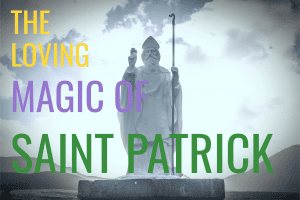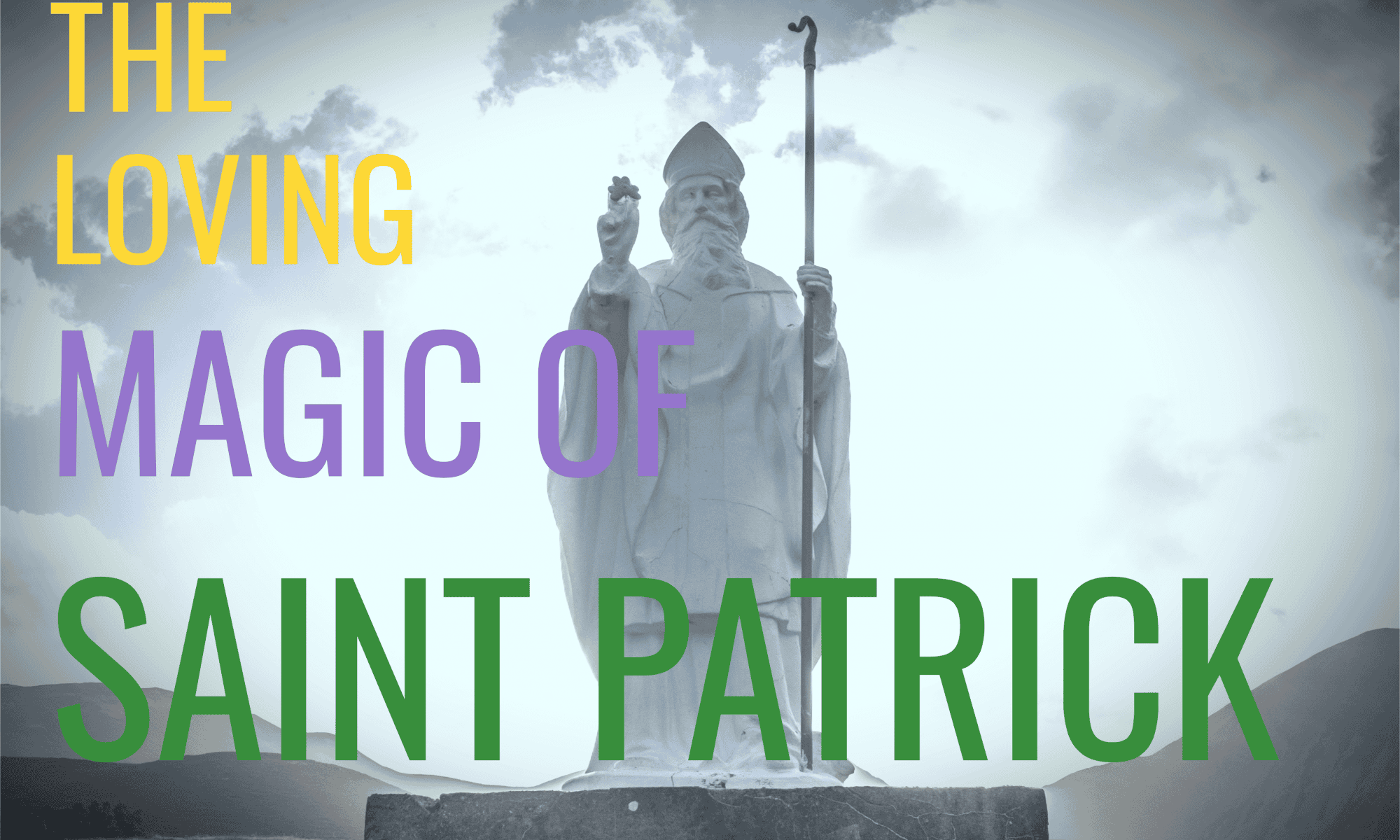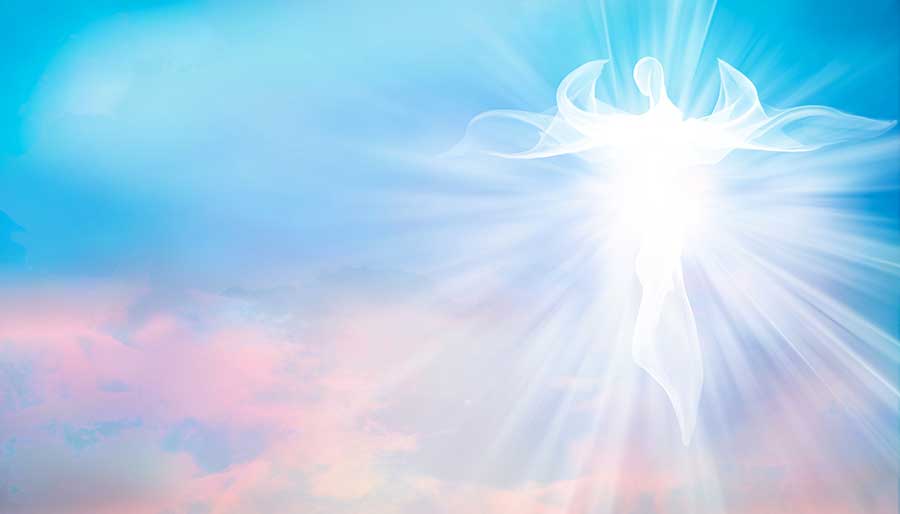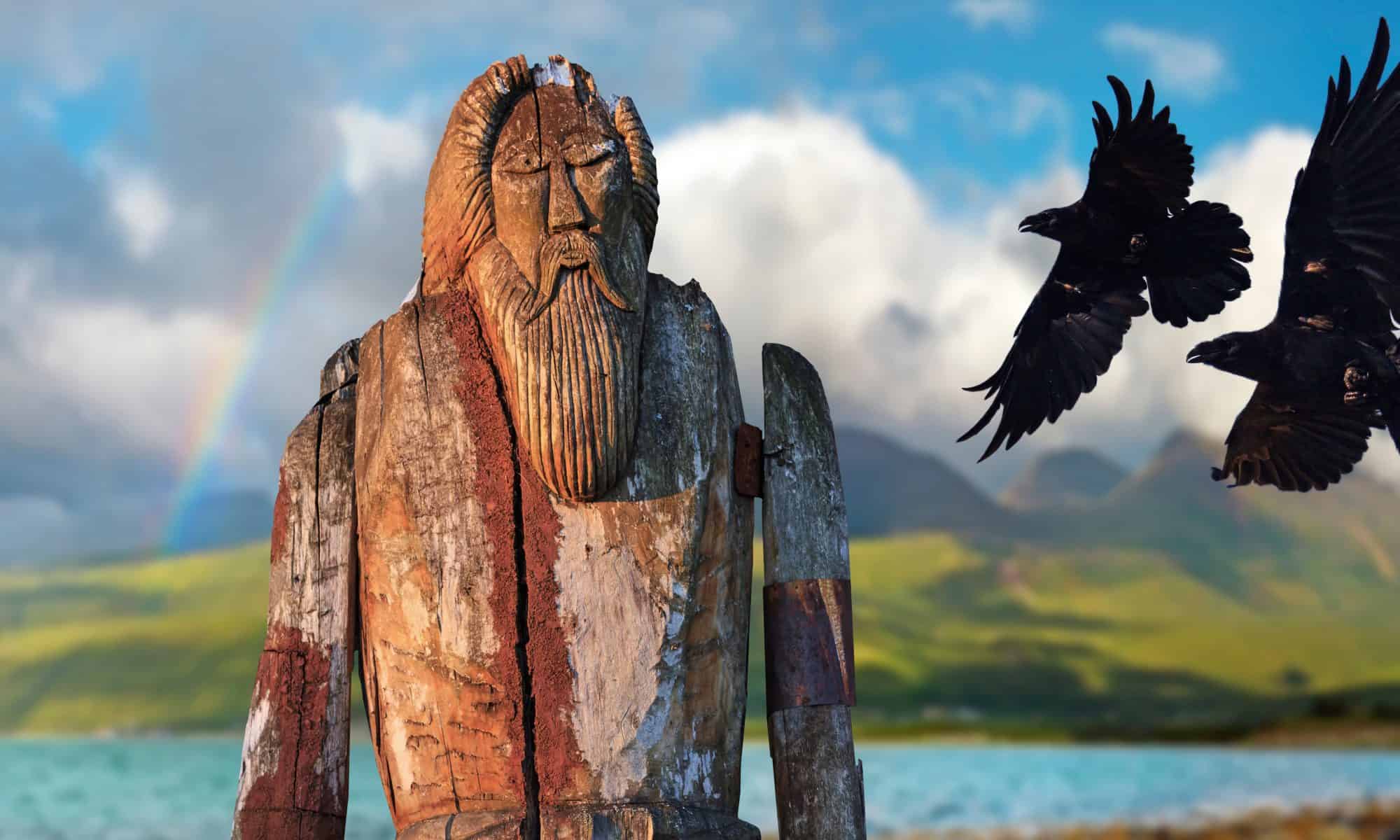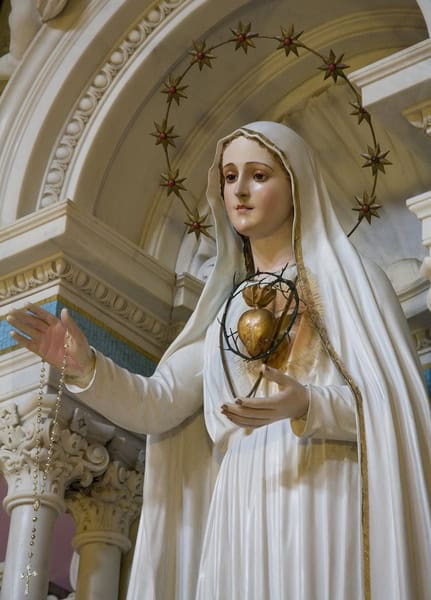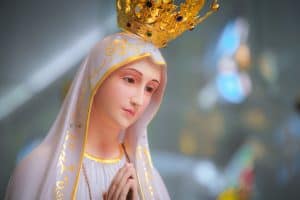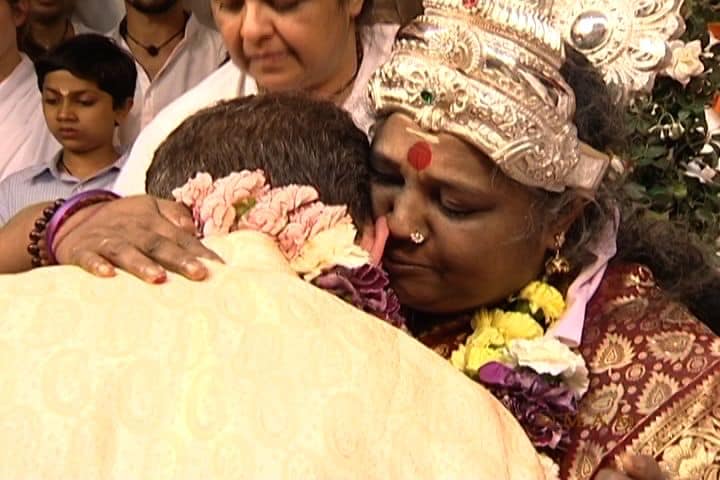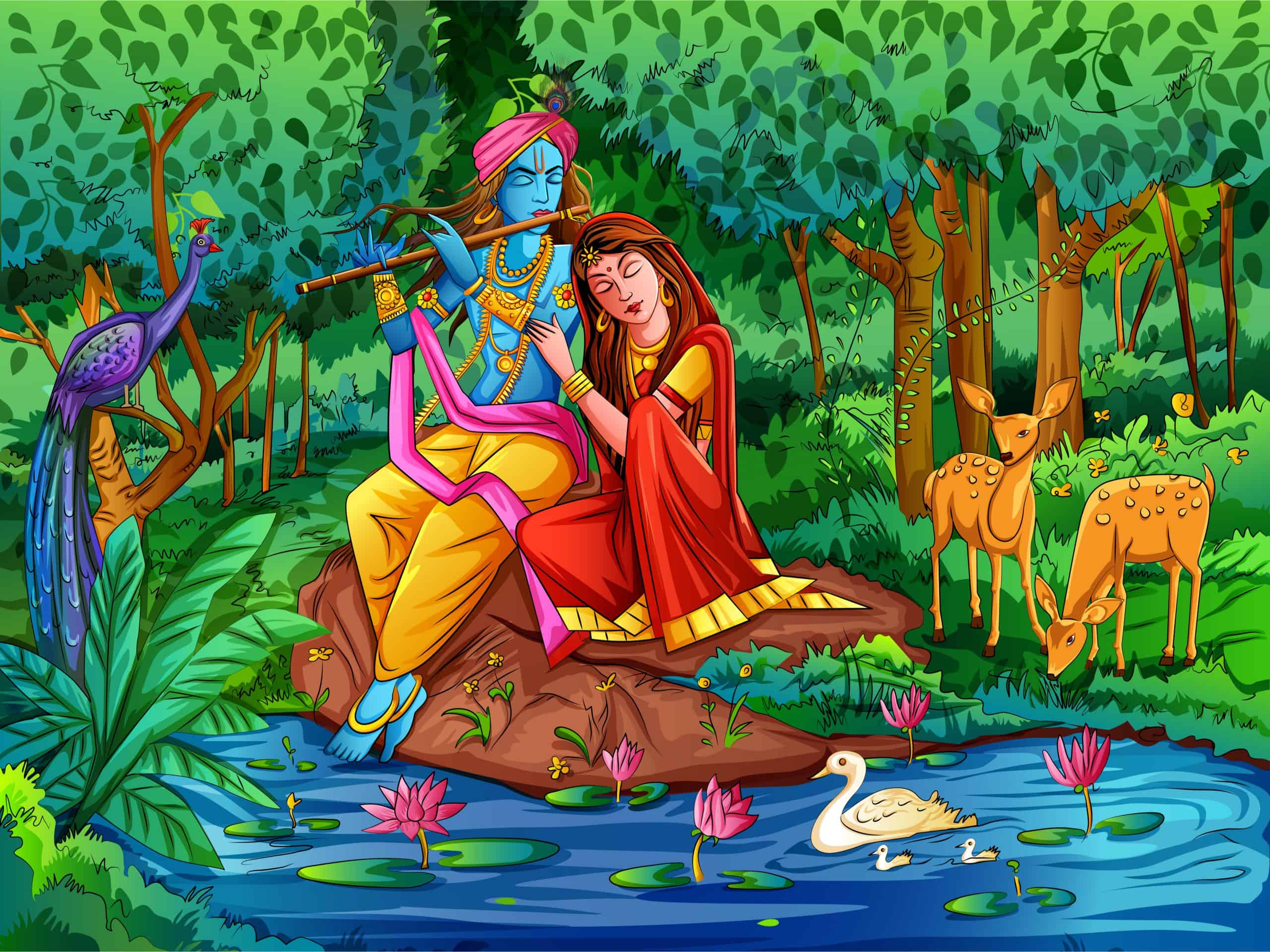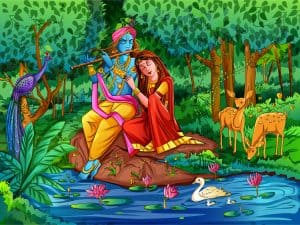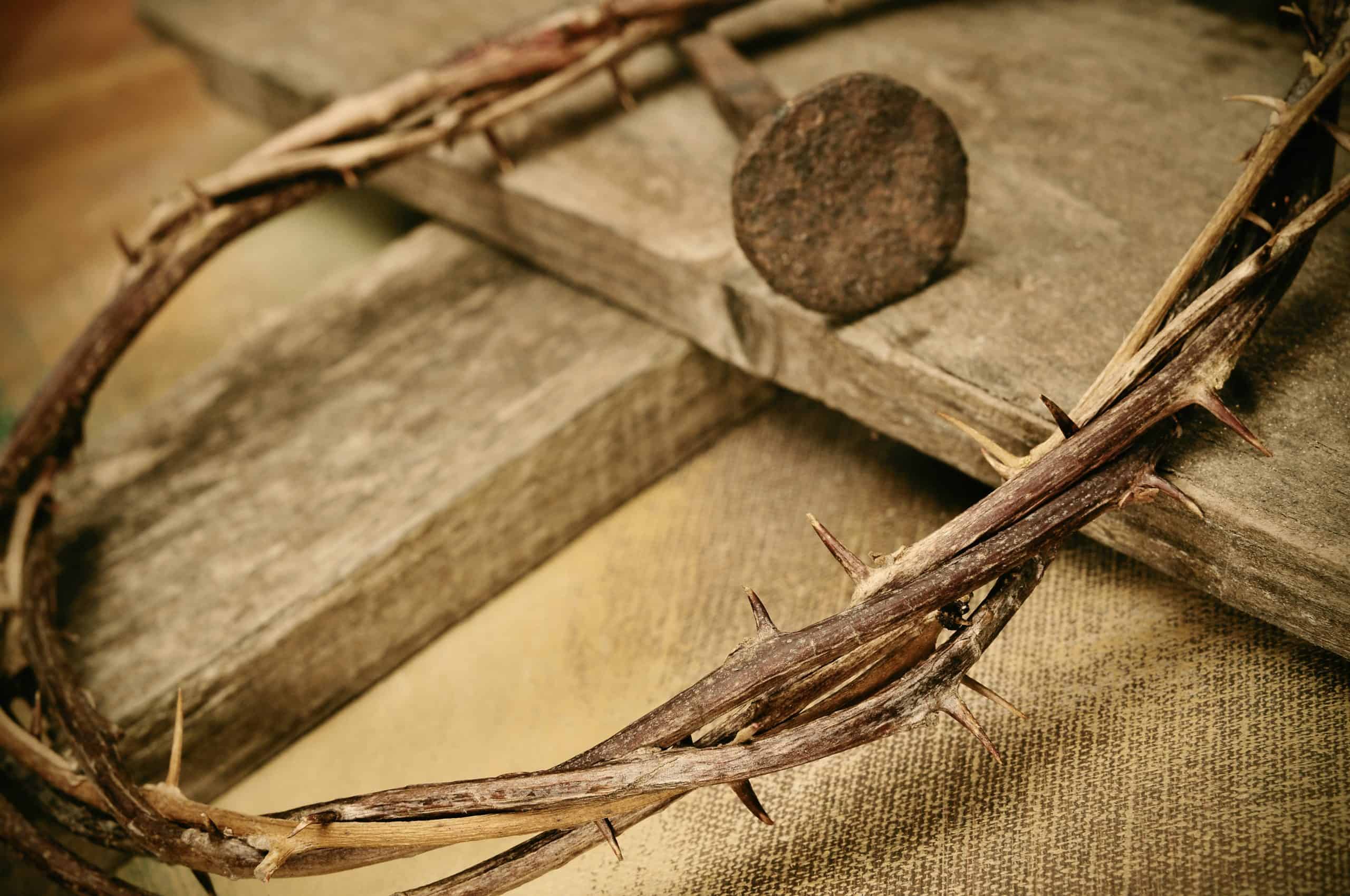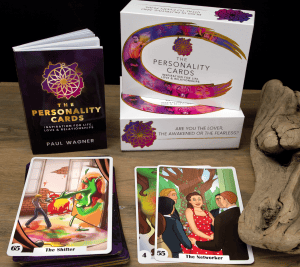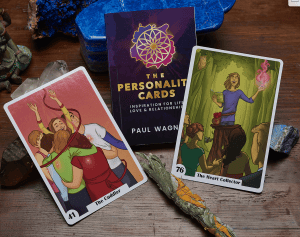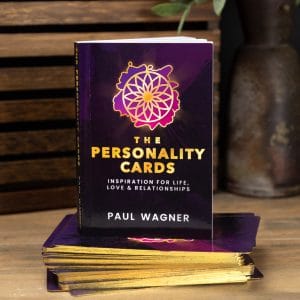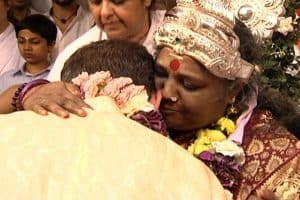
Amma, the remarkable, unmatched Hugging Saint. A personal photo (yup, that’s me!). Do not use.
As of the date of this article, Amma has hugged attendees to her programs over 40 million times. Her free events attract thousands upon thousands of people, often taking place in football stadiums. In the early days, when 50 or 60 people were in attendance, Amma was known as “Ammaji” or “Ammachi.”
It was 1990 when I first met Amma. She was seated on a tattered, cushioned chair in the center of a small, basement room in The African-Methodist Episcopal Church in Central Square, Cambridge, MA.
The moment I walked into the room, I was so profoundly struck by Amma’s light and presence that I fell to my knees and bowed to her. I spent the rest of the day sobbing in absolute bliss, happily crouched in a corner. In addition to a few Swamis and helpers, there were less than ten other people in the room.
While indulging my tears, Amma caught my eye and invited me to her chair. I was so nervous, I could barely speak. I walked toward her, awkward and self-conscious as if it were my first time walking. I bowed and she immediately took my hand, then gently bent me across her lap.
Amma then gently rubbed my body from head to toe while I cried. She massaged my scalp and forehead and patted my spine. Amma even squeezed my ears and tussled my hair. It felt as though I were embraced by the most loving bundle of light.
After 20 minutes of her healing touch, Amma lifted my head with her soft hands and pressed her cheek and lips against my ear. She lovingly whispered Sanskrit mantras to me as I absorbed every morsel of her love.
“Pure Love Transcends The Body. It Is Between Hearts. It Has Nothing To Do With Bodies.”
— Amma (Amma.org)
During this timeframe of my life, I was the host of a popular children’s TV show with fantasies of fame running through my head. After meeting Amma, my heart expanded and I changed my approach to my career and every other aspect of my life. Amidst all of my faults and challenges, Amma helped me blossom in ways that I could never have imagined.
During the years to come, Amma would ask me to open her retreats and events with spiritual comedy shows. It was lovely to sit near Amma’s chair and deliver playful lectures and videos about the hilarious things that happen within spiritual communities.
“I don’t see if it is a man or a woman. I don’t see anyone different from my own self. A continuous stream of love flows from me to all of creation. This is my inborn nature. The duty of a doctor is to treat patients. In the same way, my duty is to console those who are suffering.”
Amma’s Birth And Family
Amma, an enlightened master, was born as Sudhamani (bright, precious gem) Idamannel on September 27th, 1953, in Kerala, India. Devotees call her Amma, although she is also known as Mātā Amritānandamayī Devī, an incarnation and embodiment of The Divine Mother. Amma’s ashram, Amritapuri, is in Kerala, India.
Amma was born into a family of fishermen with six siblings, most of whom did not understand her or treat her with kindness. Amma’s commitment to her divine path is what eventually inspired every member of her family to embrace her as the Divine Mother.
Witnesses of her birth say that Amma was born without tears and with a sweet smile on her face. She was reported to have been born with bluish skin, reminiscent of stories Krishna. Even though her skin soon turned to brown, many believe Amma to be an incarnation of Krishna. From age 5 onward, Amma spent most of her time in devotional prayer.
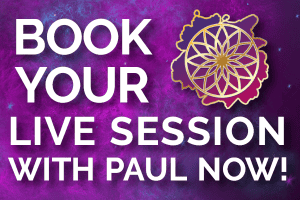
Known as “The Hugging Saint,” Amma tours the world continually, holding free programs in multiple cities on every continent. In the hotels she inhabits, Amma rejects all comfort and sleeps on the floor (requesting that all beds and pillows be removed). She barely eats, yet will hug thousands of attendees, often for longer than 24 hours at one sitting. Amma’s darshan, or blessing, comes in the form of hugs and gentle, loving whispers during the embrace.
Amma offers mantras to those who request them, and she makes herself available to people who have life-or-death questions.
“I am not interested in making believers by showing miracles; I am here to help you find the real truth, and to find liberation of the Self (Soul) through the realization of your eternal nature.”
— Amma (Amma.org)
Amma’s Mission: Hospitals, Housing, Tsunami Relief & More
Amma’s international missions, Mata Amritanandamayi Math (MAM) and Mata Amritanandamayi Mission Trust, help millions of people around the world.
In addition to spiritual education, these organizations have a long, successful record of helping the poor and uplifting humanity. She has garnered hundreds of millions of dollars in donations for disaster relief, healthcare for the poor, the environment, global hunger, and education for financially strained students.
The primary missions of Amma’s organizations are to promote activities of selfless service. The idea is based on her teachings around karma yoga, which encourages everyone to help those who are less fortunate as a prayer.
Thousands of people around the world volunteer for Amma’s organizations. This includes monastics, students, and householders (married and/or with children), who come from a long list of religions, races, creeds and ideologies.
When you attend Amma’s events, you’ll hear about her mission, “Embracing the World.” All of Amma’s charitable organizations work under this premise and title.
Ranked as the #1 private India university, Amma’s Amrita Vishwa Vidyapeetham, is an accredited university that offers degrees in Arts & Sciences, Chemistry, Biotech, Business, Education, Engineering, Nursing, Medicine, Ayurveda, and more. Students can also learn meditation, Sanskrit and yoga.

Here are a few highlights from a long list of Amma’s unique, humanitarian accomplishments:
- Awarded over 100,000 scholarships to help disadvantaged people and the many families stricken with farmer suicide
- MAM’s university, Amrita Vishwa Vidyapeetham, a 5-campus system, teaches nanotechnology, biotechnology, robotics, and satellite-enabled software solutions. Amma says that their goal is “To harness the power of modern technology to provide the effect of targeted aid to communities and individuals in crisis.”
- Built four charitable hospitals that serve the poor and disadvantaged
- Established the Amrita Institute of Medical Sciences and Research Centre (AIMS) and several HIV/AIDS care centers. The AIMS hospitals and related programs have 1,300 beds, a medical college with 400-beds, and a 210-bed Intensive Care Facility. They’ve served over 5.5 million patients since 1998.
- Amma’s MAM funds and manages over 47 grammar schools with an education that integrates spiritual and universal values
- MAM is part of the “United Nations Billion Tree Campaign” and has actively planted over 1 million trees around the world
- Amma’s SREE program and her over 5000 self-help groups serve over 100,000 women to improve their lives and support their families
- Built over 200,000 homes for the poor
- Raised and gave over $50 million to earthquake, tsunami and hurricane relief
- Awarded over 60,000 microloans to help families improve their living conditions, careers, health, and businesses
- Established nine tailoring schools and furnished them with over 2000 sewing machines
- Educated over 500 students in pursuit of their driver’s licenses to become bus, truck and taxi drivers
- Educated hundreds of young people in a variety of trades, including mobile phone and TV/VCR repair, plumbing, fashion design, and bag manufacturing/production
- Her Amrita Nidhi financial-aid program is giving out pensions to over 100,000 widows, and physically and mentally disadvantaged individuals
- Build four elderly-care homes, equipped with community prayer, ceremony and function halls
- Amma’s AYUDH helps young people integrate spiritual and universal values into their lives, as she teaches them ways they can help the elderly, homeless and disadvantaged
- Built two homes that continually help hundreds of children with food, housing, and education
There are many other services, functions, and organizations that Amma and her MAM manage or fund across the globe. Her mission represents one of the most profound humanitarian efforts in history.
Amma’s Miracles
Amma began performing miracles very early in life, including licking the sores of lepers which healed them of their debilitating disease. While she does not place emphasis on these miracles, there are many confirmed stories circulating throughout India.
During her early life and beyond, Amma was known to be extraordinarily generous and compassionate with the lower classes in society, her most impoverished neighbors, and all of the nearby animals. She would regularly forsake her own hunger and give her food to hungry cows and goats. To many, Amma was the miracle that saved their livestock and families.
Amma would also give her family’s belongings to those in need. Even as a young girl, Amma would spontaneously hug others with the hope of comforting them.
“If we penetrate deeply into all aspects and all areas of life, we will find that hidden behind everything is love. We will discover that love is the force, the power, and inspiration behind every word and every action. This applies to all people, irrespective of race, caste, creed, sect, religion, or of what work people do.”
— Amma (Amma.org)
Amma Quotes
- “Children, love can accomplish anything and everything. Love can cure diseases. Love can heal wounded hearts and transform human minds. Through love, one can overcome all obstacles. Love can help us renounce all physical, mental and intellectual tensions and thereby bring peace and happiness.”
- “True worship of God is rendering help to those who are suffering.”
- “Different people will think different things – that is the nature of the world. People have the right to have faith or not to have faith.”
- “For me, everything in creation is God, there is nothing but God. Every single object is a wonder for me.”
- “Only when human beings are able to perceive and acknowledge the Self in each other can there be real peace.”
- “All I am concerned with is what positive I can do.”
- “Compassion is Consciousness expressed through your actions and words. Compassion is the art of non-hurting. Compassion cannot hurt. Compassion cannot hurt anyone because compassion is Consciousness manifested. Consciousness cannot hurt anyone. Just as the sky cannot hurt anyone and space cannot hurt anyone, the manifestation of Consciousness, compassion, cannot hurt anyone. One who has compassion can only be compassionate.”
Amritapuri: Amma’s Home Ashram
Amma began hugging people at her home in her early teens, and more regularly as spiritual disciples took residence on her family’s property. Amma says that when people would share their troubles with her, she would listen, share advice and then hug them.
This loving ritual eventually became part of Amma’s blessing which new seekers can experience when they visit Amma. By lovingly embracing others, Amma is absorbing a measure of pain in the world, which heals hearts and helps humanity.
Amma’s home ashram, Amritapuri, is in Kerala, India, which is also Amma’s primary residence. There are only a few weeks throughout the year when Amma is not touring the world and therefore resides at Amritapuri. Her original tiny temple is still in perfect working order and often used for Pujas and Homas, ceremonies of light and love.
When visiting the ashram, you’ll find inexpensive accommodations akin to a youth hostel, delicious and affordable vegetarian meals, free spiritual education, and free programs where attendees are invited to receive Amma’s special darshan in the form of a hug.
Mornings at Amritapuri begin long before dawn, when men and women chant in separate halls. If you walk near Amma’s main temple, you can find the sweet spot between the two halls, where you’ll be drenched in waterfalls of chants occurring on either side of you. It’s a profound experience. Visitors are always welcome to attend as fellow-chanters.
Spiritual ceremonies in the forms of Pujas and Homas are performed daily, and can be of benefit to individuals, families, friends, and loved ones. If you have a personal prayer, need or desire for help, healing or cleansing, Amma’s Pujas and Homas can be ordered through her website.
Amma’s Awards And Honors
It seems that every year Amma and her organizations are recognized for their tireless efforts to serve humanity. Here is the most current list of their remarkable achievements:
- 1993: Named “President of the Hindu Faith,” at The Parliament of the World’s Religions 100th Anniversary
- 1993: Hindu of the Year, by Hinduism Today
- 1995: Address at The Interfaith Celebrations, 50th anniversary of the UN
- 1998: Care & Share International Humanitarian of the Year Award
- 2000: Keynote speaker at the Millennium World Peace Summit, UN General Assembly
- 2002: Karma Yogi of the Year, by Yoga Journal
- 2002: Gandhi-King Award for Non-Violence
- 2005: Mahavir Mahatma Award
- 2005: Centenary Legendary Award of the International Rotarians
- 2006: James Parks Morton Interfaith Award
- 2006: The Philosopher Saint Sri Jnaneswara World Peace Prize
- 2007: Le Prix Cinéma Vérité
- 2008: Mahavir Mahatma Award
- 2008: Keynote at the Summit of the Global Peace Initiative of Women
- 2010: Honorary Doctorate, The State University of New York
- 2012: Amma in the Top 100 Most Spiritually Influential, Living People
- 2013: 1st Annual Award, Vishwaretna Purskar (Gem of the World Award), by Hindu Parliament
- 2013: Proclamation by the State of Michigan, declaring Amma to be a true citizen of the world for her worldwide charitable works
- 2014: One of the 50 most powerful women religious leaders, by Huffington Post
- 2014: Kavithilakam Pandit Karuppan Award
- 2014: Participated with the first coalition of Anglican, Catholic, Orthodox, Jewish, Muslim, Hindu and Buddhist leaders (including Amma) to sign a shared commitment against modern-day slavery and human trafficking under the direction of The Global Freedom Network
- 2015: Keynote at The United Nations Academic Impact Conference
- 2015: Medal of Honor, by Ms. Evie Evangelou, Fashion 4 Development
- 2015: Special Envoy for the Protection of the Planet in the Summit of Conscience for the Climate in Paris, by French President Francois Hollande
- 2015: Golden Goody Award (Oscar for Social Good) for Amma’s Worldwide Humanitarian Charities
Amma’s Titles, Roles And Positions
While Amma is hugging people, you’ll often see her Swamis hand her a variety of cell phones. I often wondered why – until I realized that Amma is the CEO of a variety of missions.
Here are Amma’s primary roles and positions in organizations that serve millions of people across the globe:
- Founder and Chairperson, Mata Amṛtānandamayī Math
- Founder, Embracing the World
- Chancellor, Amrita Vishwa Vidyapeetham University
- Founder, Amrita Institute of Medical Sciences (AIMS Hospital)
- Parliament of the World’s Religions, International Advisory committee member
- President, Swami Vivekananda’s 150th birth anniversary celebration committee
- Member, Elijah Interfaith Institute Board of World Religious Leaders
Other Divine Mothers
Mother Meera is also known as an embodiment of The Divine Mother. Born in 1960, Mother Meera can be found touring the world giving visitors her loving blessing. This free transmission of Light, Love, and Grace is Mother’s gift to the world. Mother Meera once said, “The whole purpose of my work is in the calling down of the Paramatman Light and in helping people. For this I came – to open your hearts to the Light.” You can visit MotherMeera.org to learn more.
Sri KarunaMayi has spent her life immersed in prayer and is known for her embodiment of Divine Motherly Love, which she readily shares with all of creation, including people, animals, and plants. Karunamayi has said, “Where there is selfishness, love will not manifest, and where there is love, there is no room for selfishness.” You can learn more at her website here.
Both of these embodiments of divine love regularly tour the world, shedding their eternal light on all walks of life.
Attacks And Allegations
While there have been a few physical attacks and negative statements toward Amma, none have materialized relevant corroboration or material evidence. In the one or two public cases, every accuser recanted their stories and apologized directly to Amma and her organizations.
Despite occasional harsh treatment toward her, Amma repeatedly says that she forgives and loves all of them. Concerning one disgruntled devotee, Amma said, “Even now, Amma is only filled with love for that daughter. I am praying that virtue and goodness come. Time will shine forth the truth.”
“All those who are born will die one day. I am going ahead keeping this reality in mind. I will carry on. I will continue to give darshan to the devotees coming here to meet me.”
— Amma (Amma.org)
Books & Documentaries About Amma
There are hundreds of books written by Amma and her disciples, which can be found on her website at amma.org. Here are the television programs and documentaries that feature Amma and her remarkable work:
- River Of Love, 1999
- BBC’s Weird Weekends, “Indian Gurus,” 2000
- Darshan: The Embrace, 2005
- In God’s Name, 2007
- Science of Compassion: A Documentary on Amma, Sri Mata Amritanandamayi Devi, 2016
“There is always a lack of love. It has always been Amma’s wish that her life should become love and compassion itself. My sole mission is to love and serve one and all.”
— Amma (Amma.org)
Living With A Master
When traveling to or residing at Amma’s ashrams, everyone works as volunteers in service to the poor and disadvantaged. A volunteer might stay for a few weeks or up to several years, and possibly longer. Some people come to Amma’s ashrams to enter into periods of prayer and meditation.
Many of Amma’s devotees spend half their time working in their home cities and then travel in spurts to volunteer for Amma’s organizations, all of which serve humanity. Some devotees have portable businesses that allow them to work when needed, travel with Amma at her programs around the world, and volunteer regularly to help others.
It’s exhilarating to be around Amma, and it’s always of benefit to serve others through her karma yogi programs. As always, Amma encourages her followers and visitors to continually seek ways to serve others, no matter where they live.
Amma continually tours the world and can be found traveling throughout the United States and Canada from May through early August every year. Amma’s unique bookstore and vegan cafe travel are always a lovely and nourishing part of her programs. Admission is always free, although it’s recommended that you arrive early.
